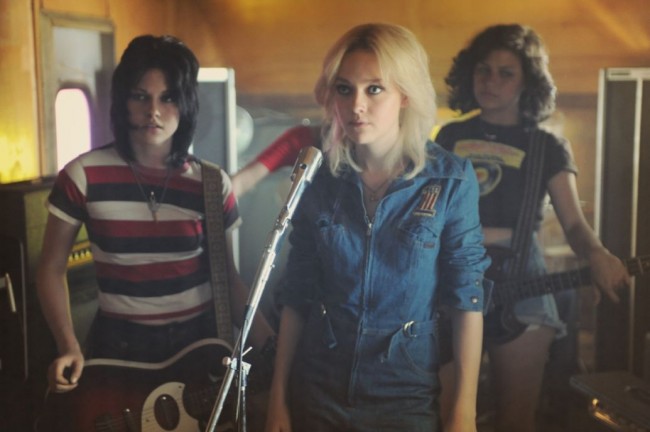The Runaways
Unkempt Hair and Uncouth Behavior

Starring: Dakota Fanning, Kristen Stewart
By Robert Patrick
Teenage girls, spiking their fingers against guitars, launch an assault on music. The year is nineteen-seventy-five, and music mogul Kim Fowley (Michael Shannon), in attempting to pounce on innovation, safety-pins four girls, of varying backgrounds, into a punk-rock band called “The Runaways.” During the band’s short tenure of lodging their fingers against frets, all while spitting overtly perverse lyrics, the group nabbed a record deal and launched the careers of rock femme-fatales Joan Jett (Kristen Stewart) and Lita Ford (Scout Taylor-Compton). But the movie, in all of its amp-gorging glory, is about The Runaways lead singer, Cherie Currie (Dakota Fanning), and her tainted run with fame.
The formation of the alcohol-guzzling all-girl band is led by the ringleader Fowley – Michael Shannon in a fantastic performance – whose unorthodox handling of artists has led him to lukewarm success in the music industry. Fowley is a real sleazeball; a kind of neo-Phil Spectre. Punctuated by a cartoon-like persona, Fowley prances around rooms, his arms flailing like a sputtering helicopter blade, as he firebombs the Runaways with curt “wisdom.” The loose cannon of an impresario is a vile rogue, one who wears more makeup than The Factory’s Candy Darling, and has more gall than journalist Lester Bangs. The Runaways, though coached by Fowley, are a regular group of misfits themselves – save for a one Cherie Currie, who begins her stay with the band as a frail, doey-eyed, meek teenager before she is culled from her incubator of Peggy Lee into an abyss of pursed lips and broken glass. Joan Jett is the curator of the band’s musical debauchery, as she does everything short of eye-gauging. Jett happy wears leather, clinches her fists, and gnashes her teeth when angered.
Lita Ford, the other main component of the group, is reduced to a pull-string doll who says little more than two lines of cheaply constructed dialogue. Even in the closing credits, where Joan and Cherie are given proper summaries of their careers, Ford is annexed from the entire procedure altogether. The total truncation of Ford’s part in the band seems, especially since she scored a top ten hit in the nineteen-eighties, a little shortsighted. More surprising is that Joan Jett, aside from a strange twenty-minute sequence near the tail end of the film, is virtually an afterthought in Sigismondi’s film. Currie takes a front seat, no doubt because of her involvement in the book that the movie was based off of, and sees most of the story revolve around her cruel battles with the band. Some of the other girls’ omissions hold the film back from being a better-than-ample biopic.
Nonetheless, I am glad that Kristen Stewart isn’t nearly as flat and angst-like as her typical persona suggests; but then again, when all is said and done, she doesn’t have much to do in the film. Stewart spends most of the picture with her fingers wrapped around the neck of her guitar, while nodding to the inspired ramblings of whomever is speaking in the same frame. Dakota Fanning, meanwhile, gets total face-time. Whether clawing at a hotel carpet; woozily cooing into the ear of a random person; or strutting around in outfits that Barbarella wouldn’t be caught dead in, Fanning gets the opportunity to shirk her wunderkind status by showing how painfully mediocre she is as an adult actress. Most of the cast, in fact, are pedestrian performers. This is especially noticeable when jawing and finger-jousting occurs, not explicitly at the hotel, but at the studio, too. The embittered rockers grind their molars in fury, as they argue in, from what we’ve seen from rock’s turbulent history, pitiful predictability.
Director Floria Sigismondi directed, before her feature film debut, several videos with notable artists such as Marilyn Manson and, appropriately enough, David Bowie. The visuals in “The Runaways” are, in many ways considering her prior endeavors, laced with hallucinatory images being chased down by a swig of frenetic guitar-mashing. Sigismondi does a fair job at recreating the grueling aspects of touring, under the influence of sex and ritualistic drug endeavors, with some great images. The phantasmagoria is spun with part terror, part teenage exuberance. And the singing, though mostly just impassioned shrieking, is performed by Stewart and Fanning in a way that faithfully recreates what The Runaways sounded like in the mid-seventies.
“The Runaways,” like all obligatory rock films, introduces its characters and their home lives, their introduction into mischief and drug abuse, and their final date with rehabilitation. The structure never changes, like most verse-chorus-verse rock songs, but it still remains entertaining.
3/5
“The Runaways” is now playing at Hillcrest Cinemas.
